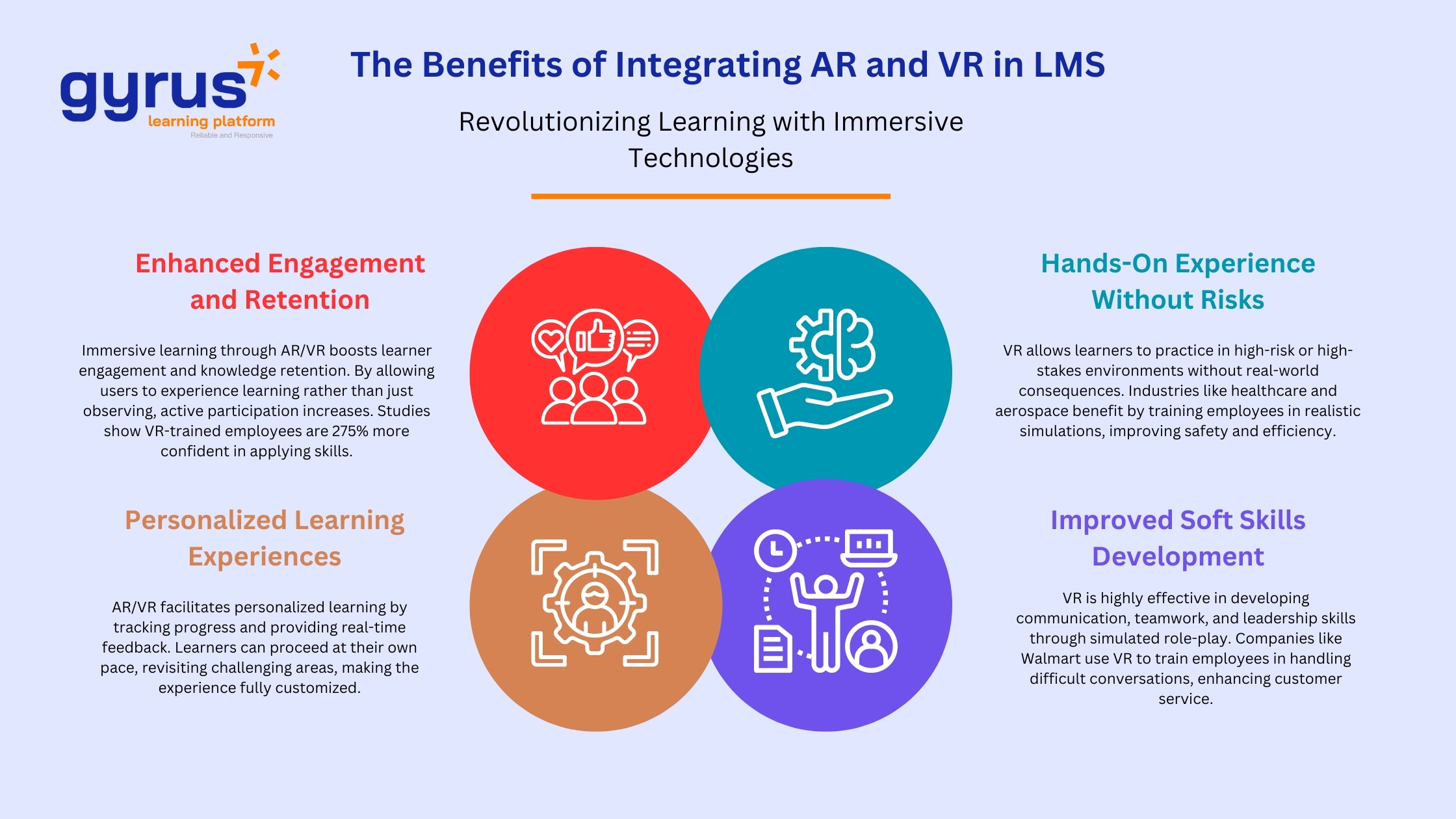As technology continues to evolve, so do the methods we use to teach and train employees. Augmented Reality (AR) and Virtual Reality (VR) are no longer just buzzwords in the tech world—they’re powerful tools that are being integrated into Learning Management Systems (LMS) to create immersive learning experiences. For companies looking to stay ahead in employee development, combining AR and VR with LMS can transform how training is delivered and absorbed.
In this blog, we’ll explore how AR and VR can be integrated into LMS platforms, how these technologies enhance corporate learning, and a few real-world examples of organizations that are successfully using immersive learning to drive engagement and skill development.
Why AR and VR in LMS Matter
Traditional training methods like text-based learning, video tutorials, and quizzes are helpful. However, they are limited to experiential learning. AR and VR provide a unique experience. They let users simulate real-world situations in a safe and controlled space. This allows employees to interact with the content actively. This type of “learning by doing” works well for complex skills and high-risk jobs. It is also useful in areas that need hands-on experience.
- AR allows learners to interact with digital information overlaid on their physical environment using smartphones or AR glasses.
- VR fully immerses learners in a virtual environment, which is ideal for high-risk scenario training.
Benefits of Integrating AR and VR in LMS

1. Enhanced Engagement and Retention
Research has shown that immersive learning through AR and VR boosts engagement and knowledge retention. By allowing learners to “experience” rather than just read or watch, it stimulates active participation, which helps commit the information to memory. In fact, a study by PwC found that employees trained via VR were four times faster to complete training compared to classroom training and were 275% more confident to apply skills learned after training. Immersive learning through AR and VR boosts engagement and knowledge retention. Allowing learners to “experience” rather than passively consume content stimulates active participation.
2. Hands-On Experience Without the Risks
One of the main advantages of VR is its ability to simulate dangerous or high-stakes environments without any real-world consequences. This is especially useful in industries like construction, healthcare, or aerospace, where mistakes in training can be costly or even dangerous. By using VR simulations, employees can practice real-life scenarios in a risk-free environment before performing tasks in the field.
3. Personalized Learning Experiences
With AR and VR, training can be highly personalized. LMS platforms can track each learner’s interactions and provide real-time feedback, allowing employees to learn at their own pace and revisit areas they may struggle with. This level of customization is difficult to achieve with traditional training methods but becomes seamless when using AR/VR technologies within an LMS.
4. Improved Soft Skills Development
Beyond technical skills, VR is highly effective in developing soft skills like communication and teamwork through role-playing scenarios. Beyond technical skills, VR is also effective for training soft skills like communication, teamwork, and leadership. For instance, role-playing scenarios can be created to simulate challenging conversations or negotiations. One great example is Walmart’s use of VR to train employees on how to handle difficult customer interactions. This not only improves employee confidence but also leads to better customer service outcomes.
How to Integrate AR and VR into Your LMS
1. Assess Your Training Needs
Evaluate which areas of your corporate training could benefit most from these technologies.
2. Develop Immersive Content
Ensure your AR and VR training content is realistic and engaging. For instance, VR simulations should provide meaningful challenges that mirror real-world tasks.
3. Track and Measure Learning Outcomes
Integrating AR and VR with your LMS allows you to track learner progress, engagement, and skill development effectively.
Industries Benefiting from AR and VR in LMS
Including a section highlighting industry-specific use cases can attract a broader audience and offer actionable insights to companies exploring these technologies.
1. Healthcare
In healthcare, AR and VR help medical professionals practice surgeries and procedures in a virtual training environment. They can do this before working on real patients. This ensures higher accuracy and lower risks.
2. Manufacturing
AR training platforms allow workers to receive real-time guidance through AR glasses while performing complex assembly tasks. Companies like Boeing are already using AR to train employees on assembling aircraft wire harnesses, improving accuracy and reducing errors.
3. Retail and Customer Service
Virtual Reality in retail training helps employees learn how to handle difficult customer interactions or manage high-stress situations, such as handling large crowds during sales events.
4. Aerospace and Defense
In high-risk industries like aerospace, VR simulations allow workers to undergo extensive, risk-free training before handling complex, dangerous tasks. AR offers real-time support for technicians, displaying instructions directly over machinery.
Real-World Examples of AR and VR in LMS

1. Accenture’s VR-Based Training for Inclusivity
Accenture has integrated VR into its training programs to teach employees about bias and inclusivity. Using VR simulations, employees experience scenarios from different perspectives, which helps them develop greater empathy and awareness of bias in the workplace. By coupling VR with their LMS, Accenture can track engagement and assess how well employees are applying what they’ve learned.
2. Boeing’s AR-Powered Workforce Training
Boeing has adopted AR to train its workers in assembling aircraft wire harnesses. By using AR glasses, employees can see detailed instructions overlaid on the components they’re working with, reducing errors and the time spent on each task. This hands-on learning experience has significantly improved both efficiency and accuracy. Read more about Boeing’s AR use case.
3. Walmart’s VR Training for Customer Service
Walmart uses VR simulations to prepare employees for high-stress situations, like handling Black Friday crowds. Employees can experience different customer service scenarios in VR, allowing them to practice responses and solutions without the pressure of a real-life situation. This VR training is fully integrated into Walmart’s LMS, allowing managers to track progress and performance. More on Walmart’s approach can be found.
Future Trends in AR and VR for LMS
To further enrich the content and attract a forward-looking audience, discussing upcoming trends can add value.
1. AI-Powered AR and VR Content
Integrating Artificial Intelligence (AI) with AR and VR in LMS platforms will allow for even more personalized learning experiences. AI could dynamically adjust simulations based on the learner’s performance, offering real-time suggestions for improvement.
2. Collaborative VR Learning
As remote work continues to grow, collaborative VR environments where employees can engage in virtual team-building and joint learning will become more popular.
3. 5G and AR/VR Accessibility
The rollout of 5G networks will make AR and VR training more accessible by enabling faster data processing and reducing latency issues, allowing companies to scale immersive learning experiences across locations.
Final Thoughts: The Future of Immersive Learning
As AR and VR technologies continue to evolve, their potential in corporate training is only growing. By integrating these immersive tools into an LMS, organizations can provide more engaging, effective, and scalable training experiences. Whether you’re looking to enhance soft skills, provide technical training, or simulate high-risk scenarios, AR and VR offer a pathway to more immersive learning that boosts retention and performance.
For companies looking to future-proof their L&D programs, exploring the integration of AR and VR in their LMS could be a game-changer. Immersive learning is no longer the future—it’s happening now.









